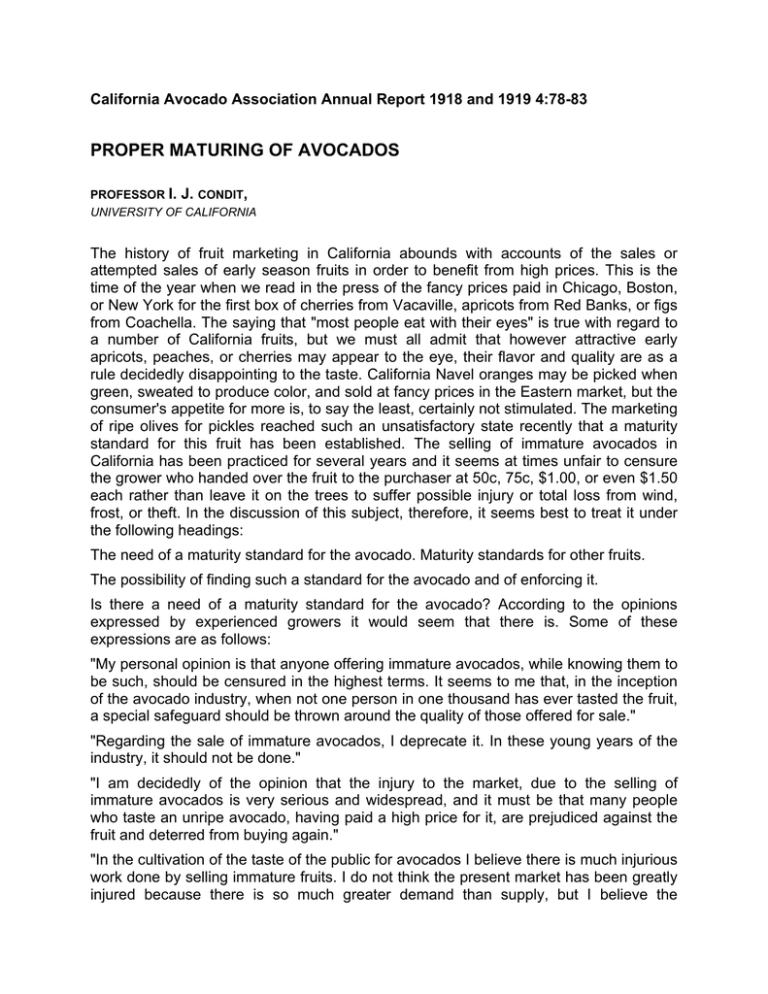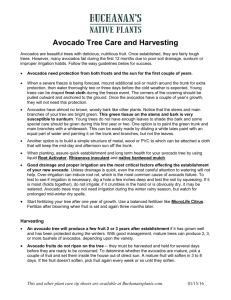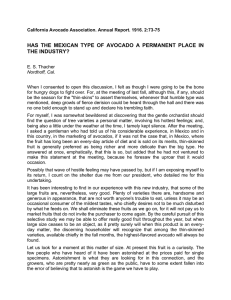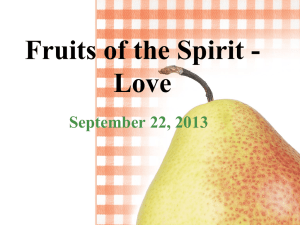PROPER MATURING OF AVOCADOS
advertisement

California Avocado Association Annual Report 1918 and 1919 4:78-83 PROPER MATURING OF AVOCADOS PROFESSOR I. J. CONDIT, UNIVERSITY OF CALIFORNIA The history of fruit marketing in California abounds with accounts of the sales or attempted sales of early season fruits in order to benefit from high prices. This is the time of the year when we read in the press of the fancy prices paid in Chicago, Boston, or New York for the first box of cherries from Vacaville, apricots from Red Banks, or figs from Coachella. The saying that "most people eat with their eyes" is true with regard to a number of California fruits, but we must all admit that however attractive early apricots, peaches, or cherries may appear to the eye, their flavor and quality are as a rule decidedly disappointing to the taste. California Navel oranges may be picked when green, sweated to produce color, and sold at fancy prices in the Eastern market, but the consumer's appetite for more is, to say the least, certainly not stimulated. The marketing of ripe olives for pickles reached such an unsatisfactory state recently that a maturity standard for this fruit has been established. The selling of immature avocados in California has been practiced for several years and it seems at times unfair to censure the grower who handed over the fruit to the purchaser at 50c, 75c, $1.00, or even $1.50 each rather than leave it on the trees to suffer possible injury or total loss from wind, frost, or theft. In the discussion of this subject, therefore, it seems best to treat it under the following headings: The need of a maturity standard for the avocado. Maturity standards for other fruits. The possibility of finding such a standard for the avocado and of enforcing it. Is there a need of a maturity standard for the avocado? According to the opinions expressed by experienced growers it would seem that there is. Some of these expressions are as follows: "My personal opinion is that anyone offering immature avocados, while knowing them to be such, should be censured in the highest terms. It seems to me that, in the inception of the avocado industry, when not one person in one thousand has ever tasted the fruit, a special safeguard should be thrown around the quality of those offered for sale." "Regarding the sale of immature avocados, I deprecate it. In these young years of the industry, it should not be done." "I am decidedly of the opinion that the injury to the market, due to the selling of immature avocados is very serious and widespread, and it must be that many people who taste an unripe avocado, having paid a high price for it, are prejudiced against the fruit and deterred from buying again." "In the cultivation of the taste of the public for avocados I believe there is much injurious work done by selling immature fruits. I do not think the present market has been greatly injured because there is so much greater demand than supply, but I believe the appreciation of the public, and especially the cultivation of the taste, is greatly injured by the immature fruits that have gone out. These fruits have sold at good prices because the public in buying them thought they were getting ripe avocados. Naturally, finding the fruits inferior, the people who bought them will value the avocado accordingly, and have a poor opinion of it instead of a good one. An adverse opinion is more difficult to overcome than a low price. I believe we should take a strong stand on this subject of putting green fruits on the market. There is and can be no justification for this practice, and all growers should feel too much interest in the future of the industry to take a hand in dealings of this nature." "I think the sale of immature avocados one of the greatest menaces to the future success of the industry and a maturity standard most desirable." "I am sure it will be hard to get the people who have purchased immature fruits ever to try again and therefore it would seem to me that the market was damaged to the extent and amount such fruit has been sold. Certainly it should not be practiced if there is any way to stop or check it." "I think that it is a very serious injury to the development of the market for avocados, to have undeveloped fruit offered on the market. It is especially harmful because the average salesman and customer are not capable of judging whether a fruit is good or not. I doubt if any legal method could be arrived at at the present time by which a maturity standard could be enforced, but think that a remedy probably lies in the education of produce men, and the development of a better standard among the growers." That there is another side to this question, however, is indicated by the following letter: "In answering yours of April 25th, I have to acknowledge that my ideas in regard to the value of immature avocados have been very much disturbed by things which have occurred during the past winter." "When some growers marketed fruit which had been blown off the trees and which seemed to me should have remained on the trees from three to four months longer to bring them to perfection, I was quite indignant and felt that the persons who bought the fruit at the retailer's had been very unjustly dealt with. "I have had to modify my opinion very materially, as I have had a remarkable evidence of the value of avocado fruit even many months before it was thoroughly ripe. An orchard at Whittier had among its trees a Murrieta Green, the fruit of which is not expected to mature before July or August. The top of this tree, bearing twenty odd fruits, was accidentally blown off and the broken part thrown aside. The fruits were not even full grown. About a week afterward I happened to see this and testing one of the fruits found that it was very fair in its qualities. The grower then tested them with me and agreed with me as regards their availability. In fact, all of them were used and I may make a comparison by saying that they were just as good as fruit of the Lyon variety which was picked from the same orchard and which was supposed to be mature at about this time. The incident above occurred in February. "In contrast to this, I saw some of the smaller avocados which were blown off last fall which were sold about town, which were absolutely worthless in every respect and which made one feel that a law should be passed, putting avocados on the same plane as immature oranges." It is a well-known fact that immature avocados have been imported from Tahiti for a number of years. The fruits are picked before they are full-grown and shipped under refrigeration. Such avocados satisfy the epicure who has an extravagant desire for things rich and rare, but not the connoisseur who is able to judge quality in fruits. Immature avocados are very satisfying when dished up with a highly-seasoned French dressing, but why pay an exorbitant price for the privilege of enjoying the dressing? Why not pour the dressing on equally tasteless but less expensive food? The California growers have less to fear from the marketing of fruit blown from the trees prematurely than from the individual who sells his fruit green simply because he is in a hurry for his money. It should therefore be the aim of the Association to establish and maintain some sort of a maturity standard for each variety. It has already been pointed out in previous meetings of this Association that we must not conclude that a fruit having a high oil content is necessarily of superior quality. Let me quote Prof. Jaffa in the 1916 Report, p. 88: "In fact it might be said that in some instances a fruit with a medium oil content might be more desirable than one with a higher content as is oftentimes the case with milk, the Holstein being preferable to the Jersey on account of the fact that the latter is too rich in fat." Although analyses of the same variety differ somewhat, Prof. Jaffa points out that those varieties which yield a high percentage of oil will do this consistently under proper conditions, while those' which yield a lower percentage will probably not increase the percentage materially by any treatment which may be given to the culture of the respective variety. While we will all agree that a half or three-fourths grown avocado will soften and become edible even though not very palatable, we must admit that the same avocado would be incomparably more satisfactory if allowed to reach a more mature state on the tree. Note, I say a "more mature state"; if left on the tree too long the flavor and quality is very likely to be impaired. An increase of from 26 to 28 per cent in fat content has been accompanied with a much poorer quality of fruit. Analyses of the fruit at Berkeley certainly show that the oil increases with the ripening but the correlation between the percentage of oil and the best edible quality has not been determined. Immature Chappelow fruits analyzed Sept. 24, 1915, showed 13.86 per cent fat; mature fruit of the same variety analyzed three days earlier showed 29.10 per cent fat. Immature Challenge fruits showed a range of 2.66, 5.78, 6.71, 7.75 per cent fat while more mature fruits showed a fat content of 16.37 per cent. Immature Fuerte fruits picked October 10, 1916, showed 11.61 per cent fat; those picked in January, 1917, showed 24 and 25 per cent, those in May and June from 26 to 30 per cent. According to Mr. J. M. Elliott, who interviewed Rivers Bros. & Co., which purchased the bulk of the avocados blown from the trees last November, the fruits within three weeks or one month of maturity were not damaged at all and under proper conditions ripened normally. These proper conditions undoubtedly include a certain percentage of humidity as well as warmth, since dry air will cause the fruit to shrivel, dry up, and become leathery. Some persons have found that avocados ripen more uniformly and quickly if buried in bran or sawdust than in the open air. MATURITY STANDARDS FOR OTHER FRUITS ORANGES Both in Florida and California there is a strong tendency to begin shipping oranges and grapefruit early in the fall before the fruit is properly matured. The incentive is the high price obtainable for anything that looks like an orange at a season when the market is practically bare of oranges. The Federal Pure Food Board decided in 1911 that sweated or artificially colored oranges were regarded as adulterated in the sense that inferiority was concealed, and therefore unsaleable unless plainly marked, "Sweated." In 1913 the Florida Legislature passed the immature fruit law forbidding the shipment of green fruit, between September 1 and November 5 of each year, which shows by test to contain in orange juice more than 1.3 per cent of acid or in grapefruit juice more than 1.75 per cent of acid. However, any fruit which showed on the tree or within 48 hours after being picked, one-half yellow color, indicating ripeness, was considered mature and exempted from the acid test. This law was the first in this country or in any country so far as I know, to hold fruit shippers to an arbitrary maturity standard. Chemical investigations of oranges were made in California during the fall of 1913 by agents of the U. S. Bureau of Chemistry and as a result the Chief of the Bureau suggested to the Citrus Protective League that a standard of eight parts of total solids to one part of acid in the juice be adopted. The Tulare County Protective Association formed in 1914, agreed to abide by this standard, the Exchange prescribed it for the "Sunkist" brand, and several counties in central and southern California passed ordinances prohibiting shipments of oranges falling below the standard. The 8 to 1 standard was embodied in the Fresh Fruit Standardization Law in 1917, with a "substantially colored" clause added. The State Horticultural Commissioner provided color charts to guide inspectors as to the meaning of "substantially colored." The state law has recently been amended so as to add a color standard of 25 per cent before picking in addition to the eight to one standard. GRAPES On account of the difficulty experienced over the shipments of table grapes of varying degrees of ripeness a maturity standard for such fruit was included in the Fresh Fruit Standardization Law, Section 8a reading as follows: "Table grapes, when packed, shall be of practically uniform quality and shall be well matured and show a sugar content of not less than seventeen per cent Balling scale except Emperor, Gros Coleman, and Cornichon which shall show not less than sixteen per cent Balling scale." The Division of Viticulture, Berkeley, examined nearly 400 samples of grapes being packed for shipment, each sample being tasted and judged by from four to six persons. The results indicated that the standard of 1 7 degrees Balling is about right as far as the public taste is concerned. During the shipping season numerous inspectors are employed to test the sugar by means of saccharometers in order to keep the fruit up to standard. OLIVES Since the avocado is more nearly comparable to the olive than to any other fruit commonly grown it is interesting to note the standards adopted for the latter fruit. Investigations made by the Bureau of Chemistry showed that the index of maturity for olives is the oil content of the flesh. As a tentative standard of maturity for Mission olives and other common varieties except Manzanillo, Ascolano, and Sevillano, an oil content of 1 7 per cent in the flesh is regarded as a minimum. The Manzanillo olive should contain a minimum of 1 5 per cent of oil in the flesh to be regarded as ripe or mature. These regulations for olives, however, have little practical value to the grower since he cannot make an oil analysis himself and even if he could do so the process requires too long a period as a rule to have much value. In general growers are advised not to pick olives for ripe pickles before a specified date unless a certain amount of color is developed; after that date the fruit is picked regardless of color. Green fruit containing less than 1 7 per cent oil can be pickled, packed, and sold as long as the product is not labeled "Ripe olives." CANTALOUPES The U. S. Bureau of Markets in May, 1918, called attention to the fact that at certain periods fully one-fourth of the cantaloupes shipped are so immature when they reach consumers as to be unpalatable and not of fair eating quality. Green melons have a depressing effect on both demand and price. If only one per cent of the annual production of the Western States should be picked and shipped green, consumers would buy more than 40,000 crates of cantaloupes that have nothing to recommend them as food. Instead of only one per cent fully ten per cent were in 1918 green when they reached far distant consumers. To insure the best eating quality when consumed as well as good carrying quality it was recommended that cantaloupes be picked just before they will slip cleanly from the stem. The State Standardization Law reads: "All cantaloupes when packed shall be fully netted, of uniform size, firm and- mature." A satisfactory maturity standard for all avocados will be difficult to establish. Nature has endowed the Sharpless, Dickinson, Challenge, Spinks, and others with a fairly sure sign of maturity in the final change of color from green to purplish—or reddish-black. With those varieties which remain green throughout, the problem is more complex. An oil analysis will not suffice as such an analysis requires too much technical skill to be used widely and the individual fruits show too much variation in fat content as influenced by the long blooming period of the tree and the irregular setting of the fruit. Neither will size of fruit suffice as sizes also vary markedly on the same tree. It seems to me that the most logical basis for a workable standard is the normal date or season for maturity. Varieties have already been classified according to season, the Fuerte from January to May, the Sharpless from October to January, the Puebla from December to February, and so on. Why can not the Committee on Classification and Registration of varieties be authorized by the Directors to submit recommendations as to the earliest date at which the fruit of a commercial variety can be termed properly mature? The Directors can then draw up an agreement according to which the members of the Association promise not to pick and ship the fruit of any commercial variety before the maturity date specified for that variety. The containers for the fruit could then be plainly labeled, "Mature Avocados, Guaranteed by the California Avocado Association." It was some such arrangement as this and not an ironclad contract by which the Tulare County Protective Association secured excellent results in preventing the shipping of immature oranges. The members made it decidedly unpleasant for growers who did not make the agreement or who failed to live up to it when made. This whole subject, however, of the proper maturity of avocados is one which needs thorough investigation and it is to be hoped that such an investigation can be carried out by the Association, the State Experiment Station, or by the United States Department of Agriculture.




